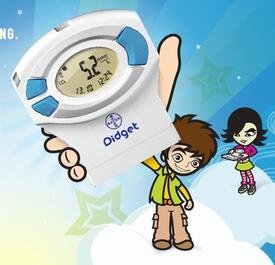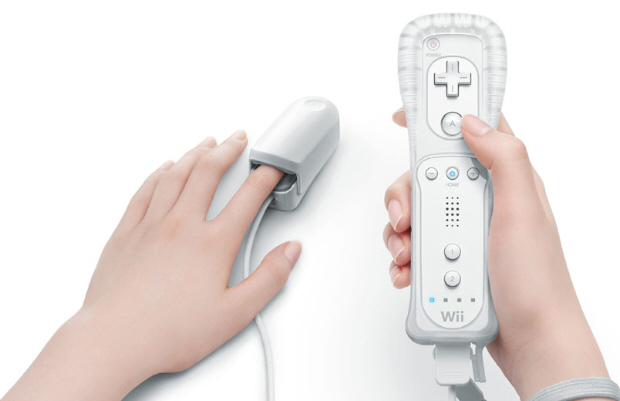This is the Bayer Didget:

Didget is a blood sugar monitor that plugs into a Nintendo DS, and interfaces with its own game cartridge. Bayer explain that it ‘converts test results into reward points that children can use to unlock new levels and buy in-game items‘. Cheap, too, at only £30 (plus the cost of a DS, obviously), but what a great idea: turning a serious health issue into both visualized data and fun. And it fits a much more pressing need than Nintendo’s own Vitality Sensor pulse monitor:

Still, other companies are also experimenting with toys and games built out of simple feedback loops driven by peripherals. Uncle Milton Industries have the Force Trainer (with obligatory Star Wars tie-in branding):

which “monitors brainwave activity and allows [the player] to control a small ball that moves through a 10 inch training tower using focus and concentration“. To clarify: you don’t think about moving the ball; the ball moves based on your brainwave patterns, and so the trick is to learn how to control the output of your brain at a very general level. The effect is still close enough to magic, though, for the purposes of entertainment.
Mattel are also getting in on the neurofeedback toys with Mind Flex:

which Engadget explains as requiring ‘players to concentrate really hard in order to power a fan that’ll float a ball through the hoops‘. Perhaps underwhelming as a game or toy, then, but the novelty factor of the neurofeedback loop has got to be worth something. Mattel reckon it’s worth $80.
More fun in the world with your DS: Tecmo’s Treasure World turns every wifi hotspot in the world, locked or otherwise, into a potential source of treasure – and you can hunt for treasure with your DS closed. And, on top of that, there’s a remarkably comprehensive web integration. Brandon Boyer at Offworld has got an ultra-detailed writeup, but if you’re short on time, the trailer video should do:
And finally, some text design from videogames and movies.

A screengrab from the forthcoming Splinter Cell: Conviction, which turns the mission objectives into text overlaying the world for only the player to see. I take a quick historical tour of the idiom of representations of text within 3D space over at infovore.org.
One Comment or Trackback
Trackback: Future Currencies | Blog | design mind 15 July 2009
[…] Looks like this is shaping to be “interesting products from a present future” week at Postcards from Connectedland. Bayer’s Didget Blood Glucose Meter for children interfaces with the Nintendo DS, and testing regularly generates points that kids can use to unlock new game levels or buy in-game items (via Tom Armitage.). […]